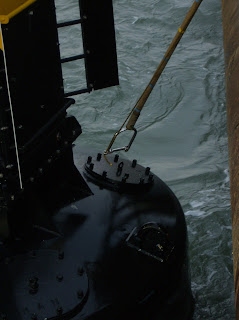So, Here I shall try and explain how we do what you expect us to do. Known in the trade as 'Buoy Bashing'. I tried to get photos of every step, though there are a couple missing. I am there to work after all and not fanny about with a camera. This Buoy is a Class 1 High Focal Cardinal Buoy. There aren't many. You can see in the final picture just how different in size they are to a Class 2. So this really is quite an adverse example, however the principals remain the same.
APPROACH BUOY
This is the Old Mans's time to shine. Using his amazing boat handling skills and intricate seamanship... hang on, I mean by turning on the ships Dynamic Positioning system, we can stay in the correct and exact same position all day. I shall go into DP in a later post as I think it's worth mentioning. The Patricia, sister ship to Galatea, hasn't yet been fitted with DP. The crew on The Pat still jump onto the buoys to attach the strops. They get all the fun!
USING THE 'HAPPY HOOKER', ATTACH THE STROP FOR THE CRANE THROUGH THE LUG OF THE BUOY, ATTACH TO CRANE, REPEAT ON OTHER SIDE OF BUOY
The Lugs are large dead eyes in the base of the buoy that are for the purpose of attaching the strops. Once through the lugs we double up the strop and hook it onto the monster crane. hooking the lug can be quite fiddly, especially when the sea is not keeping still.
BEGIN TO LIFT, AS YOU CAN SEE THERE ARE LOTS OF MUSSELS AND SEA CREATURES LIVING HERE SO...
...JETWASH THE BUOY
We only wash from and above the waterline, not only does this make the buoy more distinguishable, it makes it easier for us to do our thing. We use scrapers to get off the worst of the flora, fauna and other nautical shitty mess that accrues over time, then give it a blast when it's still outboard. This is purely as there's less mess doing it this way.
CONTINUE LIFTING
Once it is high enough to make it onto the deck, an in-haul is attached, this not only aids the crane driver to bring the buoy inboard, but also increases the stability, making it less prone to swing and clear away a whole deck of people. Safety First! Also note the size compared with the buoys in the background.Once on deck, or in this case in the well, the bridle (the loop of chain attached directly to the buoy going to a swivel attached to the chain heading to the sea bed) is disconnected, taking off the load from the chain which we now start to bring on board.
The chain is pinned in place, a hook lowered and attached onto the chain going into the sea, then it is lifted, flaked below deck, then a hook lowered to repeat the process until we can get the sinker onboard.
It's at this point that one hopes it'll be just chain and sinker that arises, with nothing else fouling the chain. So far we've picked up an anchor weighing a tonne with about 50 fathoms of cable, and an old concrete sinker. It has been known of an unexploded bomb coming up with one sinker.
ONCE ON DECK, CLIMB TO TOP OF BUOY, CHECKING THAT THE LIGHT, BATTERIES AND REGULATOR ARE OK. MEANWHILE ON DECK WE ARE CHECKING THE THICKNESS OF THE CHAIN, CONDITION OF THE SINKER AND FOR ANY WEAR AND TEAR ON THE SHACKLES.
If the chain is too thin, it is replaced, as for anything else that is deemed unfit for purpose.
ALL OK!!! REVERSE PROCESS
Though we turn the hooks around in the lugs as to swing the buoy around and wash the other side of it.
Also now we have attached lines to the strops, as when the hooks go slack they can get tangled around the top marker and cause all sorts of bother. By pulling like nutters on these ropes we can get the strops and hooks away from the buoy pretty swiftly.
Say good bye, cup of tea, rollie, and jobs a goodun.
If all goes smoothly we can get a Buoy lifted, checked and back in the 'Oggin in little over an hour. That's 500 plus years of doing it every day. Ask them on the Pat, some of them have been there for about that time.





No comments:
Post a Comment
I would like to encourage comments of all kinds. Positive, negative, informative, evocative...
Your opinions, suggestions and thoughts matter to me so please feel free to get in touch and comment.